Table of Contents
TOWARD THE END OF NŪR AL-DĪN'S REIGN the Ornamented Style was challenged in Aleppo by a sharply contrasting new style, which I call the Plain Style. The Ornamented Style continued in use, but disappeared rapidly.
Two architects known by name can be associated with many of the late twelfth-century monuments that illustrate this stylistic development, and it is convenient to present their works out of chronological order. The Lower Maqâm Ibrâhîm in the Citadel, built by Nûr al-Dîn in 563/1167–68, the same year he founded his first funerary madrasah in Damascus, is the first surviving building in the Plain Style. In order to delineate the career of its architect I shall approach the Lower Maqâm through a monument built almost twenty years after Nûr al-Dîn died, by one of his followers: the Madrasah al-Shâdhbakhtîyah. Likewise, the earliest extant monument built by another architect is the Mashhad al-Muhassin outside Aleppo, but its connection with other works of the same man can best be shown by approaching it through monuments in Ma`arat al-Nu`mân.
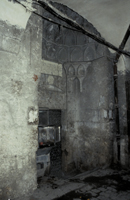
Figure 1. Madrasah al-Shâdhbakhtîyah, portal.
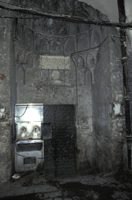
Figure 2. Madrasah al-Shâdhbakhtîyah, portal.
When Nûr al-Dîn died in 569/1174, Aleppo sprang to arms. According to Ibn Khallikân, Jamâl al-Dîn Shâdhbakht, a Hindî (i.e., Indian) eunuch who had served Nûr al-Dîn, evidently as a bureaucrat, occupied the Citadel of Aleppo along with Shams al-Dîn `Alî b. al-Dâyah, the most powerful of the amirs of Nûr al-Dîn and representative of a family that had long held the governorship.1
Al-Malik al-Sâlih Nûr al-Dîn Ismâ`îl b. Mahmûd, Nûr al-Dîn's ten or eleven year old son, was in Damascus when his father died. The Nûrî amirs with him in Damascus took him to Aleppo, where there was civil turmoil. When this group arrived in the city Shams al-Dîn `Alî b. al-Dâyah and his brother Hasan were arrested; while little is said subsequently of Shâdhbakht, his monuments and their inscriptions show that he exercised power during al-Malik al-Sâlih's reign (569–77/1174–81).2
After taking Damascus and Homs, Salah al-Dîn marched on Aleppo, and in the slow, confused mixture of diplomacy and belligerence so common in such affairs, besieged the city thrice before leaving it under pressure from Sayf al-Dîn Ghâzî b. Qutb al-Dîn Maudûd b. `Imâd al-Dîn Zangî, then reigning at Mosul.
Al-Malik al-Sâlih Ismâ`îl was barely an adult when he died in 577/1181. The political and military situation of the remaining Zangids was no longer so strong, and while they disputed control of the city for two years, they surrendered Aleppo to Salâh al-Dîn in 579/1183.3
Upon assuming control of Aleppo, Salâh al-Dîn appointed his ten year old son Abû Mansûr Abu'l-Fath Ghâzî as governor. Within months Ghâzî gave up the city to his uncle, Salâh al-Dîn's brother al-Malik al-`Ādil I Sayf al-Dîn, but he regained it in 582/1186 and ruled for thirty years, until 613/1216, as al-Malik al-Zâhir Ghiyâth al-Dîn, untroubled by changes of power in Cairo and Damascus.
In the course of his life Shâdhbakht built two madrasahs, one outside the city and one inside. The Madrasah al-Shâdhbakhtîyah intra muros, dated by inscription before 589/1193, survives on the south side of the main sûq, close to its eastern end at the Citadel.4
The fact that Shâdhbakht was able to found and endow a madrasah in 589/1193, the year Salâh al-Dîn died, shows that he and his fortune had survived the dynastic change from Zangid to Ayyûbid rule, but while some of his administrative positions are listed by Ibn Shaddâd, how he weathered this transition is not described. He was a personal servant of Nûr al-Dîn rather than an amir, and so posed no military threat.
Both of Shâdhbakht's madrasahs were for the Hanafîs, and he stipulated that both should be served by the same professor. According to Ibn Shaddâd, when the madrasah intra muros was completed Shâdhbakht hired a man from Sinjar as its professor, but al-Malik al-Zâhir ordered him to hire someone else instead.5
I cannot quite make out the bureaucratic power play involved here.
Shâdhbakht's roles as functionary and patron of architecture can be elucidated by inscriptions both on the portal of this madrasah and elsewhere in Aleppo.
Aside from its mihrab, the building bears three inscriptions.6 The roundel centered in the relieving arch of the entry's lintel gives the name of Qâsim b. Sa`îd, presumably the architect.
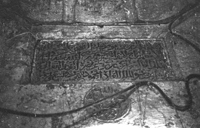
Figure 3. Inscribed roundel and waqf inscription.
Herzfeld speculated that this man was the son of Sa`îd al-Muqaddasî, who signed the Shu`aybîyah in a similar roundel, also in the center of an arch. This seems entirely likely; Qâsim is likely to have been the son of an architect, and if so, he may have referred to his father by given name because that name was publicly known in the city. If Qâsim was indeed the son of Sa`îd b. Muqaddasî, then the transition from the Ornamented Style to the Plain Style took place even within the same family.
The waqf inscription, in a rectangular panel above the relieving arch with Sa`îd's signature, thats that Shâdhbakht, freedman of al-Malik al-`Ādil Mahmûd b. Zangî (Nûr al-Dîn), endowed the madrasah in favor of the Hanîfîs, in 589/1193, naming al-Malik al-Zâhir as the ruler. On the entry doors Herzfeld reported reading on the door knockers (now lost?), “in the age of Al-Malik al-Zâhir.”
As this is not a foundation inscription, but a waqf inscription, the actual date of completion may have been earlier, even before al-Malik al-Zâhir returned to Aleppo in 582/1186, but in the absence of evidence to that effect, we may suppose that the waqf inscription was executed soon after the completion of the building, and that Shâdhbakht, having neither natural heirs nor hopes of any, endowed his buildings as they were completed.
This was not the first inscription in Aleppo to name Shâdhbakht, as Herzfeld pointed out. Aside from his extramural madrasah, for which no date can be established, he is also named in two inscriptions in the Lower Maqâm Ibrâhîm in the Citadel (which also has an inscription naming Nûr al-Dîn as its founder).
On a rectangular panel now over the entry to the courtyard of the shrine he is named as governor (and was therefore presumably involved in the unspecified work) when construction was ordered by al-Malik al-Sâlih Nûr al-Dîn Abu'l-Fath Ismâ`îl, the son of Nûr al-Dîn, in 575/1179–80.
On the curious console that projects from the west end of the prayer hall's courtyard facade, an inscription records a waqf he made, and calls him “al-Malikî al-`Ādilî.” Herzfeld argued that normally this epithet would have been applied to followers of al-Malik al-`Ādil Nûr al-Dîn only before his death, but that here it was used after Nûr al-Dîn's death because “al-Malik al-`Ādil” was the name by which Nûr al-Dîn was usually called in such contexts (rather than “Nûr al-Dîn”). He concluded that both inscriptions belonged to a reconstruction of the cistern in the shrine's courtyard, work executed in 575/1179–80. I shall return to this point in discussing the Lower Maqâm.
Shâdhbakht was also mentioned in one of two lost inscriptions that Sauvaget and Herzfeld connected with the historical sources. In this context the first, the foundation inscription of the Khânaqâh of Sunqurjâh, merely establishes the existence of that institution.
The second inscription was apparently located immediately adjacent to this same Khânaqâh of Sunqurjâh, on a stone column. It was dated 564/1168–69 and stated that “this building” (bunîyah) was erect during the reign of al-`Ādil (Nûr al-Dîn) for the benefit of the adjacent Khânaqâh al-Mujâhidîyah, Shâdhbakht being the wâlî or trustee of the waqf.7 It was thus a commercial building of some sort, built ten years after the khânaqâh was founded and perhaps after the death of Sunqurjâh. It was likely a venture of the waqf controlled by Shâdhbakht, who may have served in this capacity for many of Nûr al-Dîn's amirs.
Both buildings were south of the Dâr al-`Adl, which was below the entry to the Citadel, on its south. A cluster of buildings constructed by Nûr al-Dîn and his followers grew up here. Of these, only the later Madrasah al-Sultânîyah survives, but these were important and prominent buildings.8 This prominence explains why Ibn Shaddâd does not bother to explain the Khânaqâh of Sunqurjâh and Ibn al-Shihnah remarks that it was well known.
From this miscellany of information it can be suggested that Shâdhbakht probably built his own madrasah in his old age, or at least after he retired, as he was a servant of the Zangids and not the Ayyûbids. While to the modern visitor it seems part of the sûq today, well removed from the neighborhood of the citadel, it was actually not far from a cluster of buildings at the foot of the Citadel built by Nûr al-Dîn and his followers, and it would be sensible to seek the source of its style there. It can also be seen that Shâdhbakht had been involved in the construction of public buildings at the highest level of patronage. When it came time for him to find an architect for his own intramural madrasah he is likely to have turned to someone he had dealt with previously, the favored architect of the Nûrî amirs. The close stylistic correspondence of the Shâdhbakhtîyah with the Lower Maqâm, built by Nûr al-Dîn, confirms this supposition. The architect who signed the portal of the Madrasah al-Shâdhbakhtîyah, Qâsim b. Sa`îd, was therefore probably a prominent architect before he designed the Shâdhbakhtîyah, and had probably designed other buildings in the same style, such as the Lower Maqâm and the Masjid al-Khwâjah.
By reason of its patronage and architect the Madrasah al-Shâdhbakhtîyah is a sensitive indicator of current taste, and the rareness of buildings of this period makes it all the more interesting. The portal displays the earliest extant stone muqarnas semidome, and the îwân-hall is the earliest extant in Aleppo.9
The plan is compact, as the site was difficult. The tomb was placed on the street facade, separated from the portal by the blank back of the îwân-hall. Beyond the nearly square courtyard is the prayer hall, as tall as the îwân-hall. On the west the courtyard was bordered by an arcade about 2.5 m. deep. On the east side of the courtyard both Creswell's and Herzfeld's plans show a series of small rooms opening into it. This area has since been rebuilt, and those rooms are gone, but they were very likely later rebuilding, after the collapse of the east arcade. (It appears that the tomb chamber projected into the arcade about a meter, but the back walls of the lost chambers, as planned, are aligned appropriately.) Beyond this area were further rooms, but whether they were original I cannot say. The tomb is entered through a passage from the îwân-hall. For an idea of how these side facades of the courtyard may have looked one may consider the closely related Madrasah Abu'l-Fawâris at Ma`arat al-Nu`mân, built five years later by another architect.
But it is possible that two unmatched sets of basalt bases and columns, discovered on the site in 1992, came from this arcade also, at either first or second story level.10 Including the basalt fragments reused in the vestibule, these spolia suggest that a public building such as a church occupied the site in Late Antiquity.
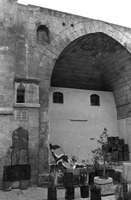
Figure 4. View of iwân-hall.
When it was new this building surely dominated the approach along the main street of the sûq to the area below the Citadel. Ibn Jubayr, in 1184, remarked that all of the sûqs were roofed with wood,11 but to judge from the height of the street facade, all of the building should have been visible, rising high above the structures facing it. In support of this supposition is the fact that the shops along the sûq side of the madrasah, between the portal and the tomb, are quite shallow, and have in fact been built into the back of the îwân-hall. This circumstance indicates that the street at this point was not sûq in the late sixth/twelfth century. One can confidently imagine the appearance of the street with the ground level a meter to two meters below the present one, no roof overhead, and a clear view of the full height of the portal, the tomb, and the back of the tall îwân-hall.
The portal is really quite simple, and much simpler than portals of the Ornamented Style. The jambs of the door frame are absolutely plain, as is the monolithic lintel, which spans the entire width of the bay. Immediately above the lintel is a rather high, two-centered relieving arch, with the circular architect's inscription in its center, and the lowest tier of the muqarnas. In the next course up are the waqf inscription and the second tier of muqarnas. So far as can be seen today, the frontal arch of the portal's semidome was entirely plain, with the muqarnas set back from it half a dozen centimeters. There is no bevelling of the ashlars and no emphasis on their coursing or stereotomy, except for the muqarnas.
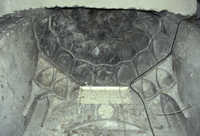
Figure 5. Portal, vault from below.
The muqarnas vault is unlike earlier muqarnases in Damascus in that it rises from a squinchlike zone of transition rather than a square horizontal base.
In a “Muqarnas Questionnaire,” in Appendix A, I have assembled a series of questions applicable to any muqarnas vault, skewed toward Syrian stone muqarnases. Describing the Shâdhbakhtîyah portal in terms of these questions, it is half as deep as it is wide, the muqarnas springs from two tiers of muqarnas squinches without corbels, the height of the full muqarnas is only two tiers, the cells vary in height and depth, the geometry is simple, based on the rotation of squares or octagons, it employs no true branches brackets or rolled square brackets, it is topped by a tall gored conch with a small fluted semidome at the very apex, there is no development of recesses or “flues” in the muqarnas, the muqarnas is contained behind a smooth pointed frontal arch, no muqarnas cells are gored or otherwise decorated, and the archivolt appears to be undecorated.
The bronze-covered doors are presumably original, as Herzfeld recorded an inscription on one of the door knockers (absent today). They are otherwise decorated only with an all-over geometric pattern created by the fitting of the metal plates.
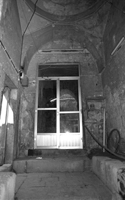
Figure 6. Portal, viewed from vestibule.
The vestibule is separated from the portal bay by a short passage, as deep as a single door leaf. Viewed from the vestibule, the door frame of the entry is off-center to the west. This oddity appears to have been the result of an adjustment in the plan before or during construction, in which the vestibule was narrowed somewhat. Narrowing the vestibule made it rectangular in plan, and so an otherwise pointless shallow arch was inserted on the north side of the chamber to convert the rectangle to a square at the level of the springing of the vault.12
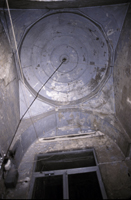
Figure 7. Vestibule, vault (79-15/24a).
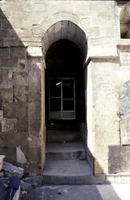
Figure 8. Vestibule from courtyard.
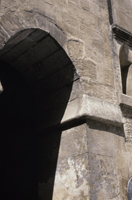
Figure 9. Arch of doorway from vestibule to courtyard.
While the portal's muqarnas is novel, the masonry of the vestibule's vault is recognizably Aleppan in the bevelling of the courses of the rather flat dome. The intrados of the arch over the doorway leading to the courtyard arcade is also bevelled. It springs from consoles with a slumping outline that continue onto the south side and help give the arch its horseshoe profile.13
The triangular pendentives of the dome, which I term split pendentives, appear here for the first time in an extant Aleppan monument, but may already have been part of the local repertoire. The door on the west side of the vestibule, pushed to the north end of the west wall, is topped by a monolithic lintel and a four-stone pointed relieving arch of the same profile as that of the portal.
The vestibule gave access to the now-lost west arcade of the courtyard, and through a door to the west, to a staircase and what is now, and probably was in the twelfth century, a latrine.

Figure 10. Late fountain.
No original masonry remains to the west of the doorway into the west arcade. Immediately to its east is a small doorway providing access to a fountain, restored at a late date. This fountain is inserted in the west side of the îwân-hall, which occupies almost all of the north side of the courtyard.
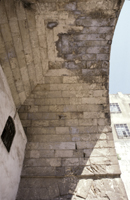
Figure 11. Iwân-hall vault.
The îwân-hall is covered with a pointed mitered vault, and the stones of the vault and the frontal arch of the îwân-hall are bevelled to emphasize their coursing. On the courtyard facade two arched, blank, flat-backed niches occupy the spandrels. The back wall of the îwân-hall is not available for inspection, and may have been destroyed when shops were inserted. Likewise, the northern of the two recesses that are shown on the plans in the îwân-hall's west side is inaccessible, though part of its relieving arch can be seen. The other, fully visible relieving arch, over the southern of the two recesses on this side of the îwân-hall, has the same profile as those of the portal and vestibule, but the voussoirs are shorter. On the east side of the îwân-hall the voussoirs are of normal height.
No original masonry remains on the east side of the courtyard, which has been repaved in the twentieth century. In the course of this repaving a large octagonal tank (shown on Creswell's plan but not Herzfeld's) was removed, and while it is not clear that the tank was original, it is a good guess that it was.
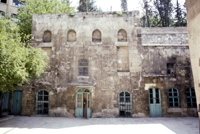
Figure 12. Prayer hall facade.
The facade of the prayer hall shows clearly what the Plain Style is about. As with many Ayyûbid monuments in Aleppo, the larger openings, both the central doorway and the two lower side doors, were filled with masonry when their great wooden doors rotted away (under the Ottomans, from the profiles of the door arches), and there has been some minor reconstruction of the masonry, but there is not now and never was no decoration at all on this facade. Above the side doors are blank, flat-backed rectangular recesses, rising to the top of the arch of the central doorway, where wooden beams run across the facade. Above, four blank flat-backed niches with pointed arches correspond to those in the spandrels of the îwân-hall's facade. Indeed, the excessive height of the prayer hall facade seems to have been designed to correspond to the îwân-hall, and it is not fanciful to imagine that the elevations of the east and west sides of the courtyard also followed the same scheme, with second-story openings the same height as the rectangular recesses of the prayer hall and arched lights above.
Conceivably these blank recesses were filled with some sort of woodwork to match the large expanses of wood that closed the three doorways; in any event woodwork was the sole decoration of the facade.
The interior of the prayer hall displays many of the stylistic features already remarked. It is also a fine exercise in the integration of interior space. The central dome, on split pendentives, is adjoined directly by two mitered vaults springing smoothly from the walls, without intervening moldings. Each of the mitered vaults is half the width of the central bay. The curved sides of these vaults, the lack of any intervening elements, and the generous and consistent lighting of the prayer hall combine to join these spaces into a whole as effectively as in any contemporary structure.
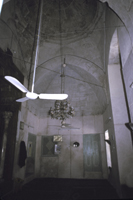
Figure 13. Prayer hall vaults.
The masonry of each of the vaults is bevelled along its horizontal joints, except for a strip down the center of the east and west sides, where the horizontal joints are left plain and smooth. This plain strip seems to have been intended to correspond to the smooth undersides of the frontal arches of the vaults, although there is of course no structural arch behind it. This subtle manipulation of masonry details is quite characteristic of the Ornamented Style.
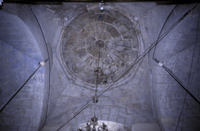
Figure 14. Prayer hall dome.
The dome does not rise so directly from its curved and split pendentives, which have been cut so as to produce small lunettes at the apices of the main supporting arches, a small play with stereotomy and the construction of space by defining it with planes. At the top of the pendentives the transition from the octagon to the circle is eased by eight small cylindrical consoles, traversed by a grooved molding that runs entirely around the tops of the pendentives. As these consoles appear to be pierced on their undersides, they seem to have been intended for the suspension of lamps.
The dome is separated from the octagon formed by the top of the pendentives by a strong molding. While it has been rebuilt and its stones have been somewhat damaged, it appears that shallow recessed slots corresponding in width to one or two stones, were cut into the masonry to produce an effect of relief arches, as in the vaulting of the side bays. The central boss may have had some decorative form, but it is not now distinguishable.
The treatment of pendentives and dome defines the space by curved flat planes and sets off the dome itself as a separate volume. This approach is rather different from that employed in the portal, where space is defined by use of repeated solid forms, and the semidome is unified with the space below. Along with the continued use of bevelling, this approach to space shows that despite the introduction of the muqarnas and the elimination of most relief ornament, Qâsim b. Sa`îd, the architect of the Shâdhbakhtîyah, had been trained in the aesthetic of the Ornamented Style.
Under the dome is the mihrab, which is a fine example of the medium most prized in Ayyûbid Aleppo for this application: multicolored inlaid marble. The overall form of the mihrab descends from that of the mihrab of 505/1112 at the Maqâm Ibrâhîm at Sâlihîn. The niche itself is of normal size, flanked by columns, and is lined and surrounded with multicolored marble panelling. In the cylinder of the niche bands of ocher marble enclose recessed panels of brown marble. A frame of doubled tubes, twisted at intervals and lined with a imbricated dogtooth molding in low relief, runs around the cylinder of the niche and the columns, turning back on itself in the manner of the mihrab at the Maqâm Ibrâhîm at Sâlihîn. A lightly incised braided molding runs under this frame at the foot of the cylinder, turning out and up on either side of the columns and stopping at the springing of the niche head. The marble blocks below the column bases continue to either side a short distance.
At the base of the interior of the niche head is a thick band of ocher marble, and above the banding of the cylinder is continued. At the top of the semidome is a pattern of eight small recessed rays, radiating from the anchorage for a suspended lamp.
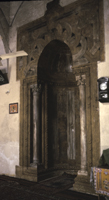
Figure 15. Mihrab.
The frontal arch of the niche head is treated as a set of interlaced arching bands with doubled grooves down the center of the bands. The surround is somewhat larger than the mihrab, extending to the width of the marble blocks below the column bases. The spandrels of the surround are revetted with circular bands continuing the lines of some of the arching bands of the frontal arch, and other bands continue out and around them, knotting in the corners and at the top of the surround, where a small panel includes the inscription of the artisans who made the mihrab, Abu'l-Rija' and Abû `Abd Allâh, who describe themselves as the two sons of Yahyâ.14
Later, the same men also signed another such mihrab in the Mashhad al-Husayn, where they gave Yahyâ the nisbah al-Khatarânî(?). Herzfeld suggested that it was two other sons of the same Yahyâ who signed the lost wooden mihrab in the Lower Maqâm and the lost wooden minbar ordered by Nûr al-Dîn in 564/1168–69 for the Aqsâ Mosque, on which Yahyâ is called Yahyâ al-Halabî.15 However, the coincidence of the name Yahyâ alone does not justify connecting mihrabs in different media and quite different styles.
The recessing of panels in the mihrab continues the theme of recessed bands in the dome, and indicates that the architect and the designer of the mihrab did not work entirely separately, and may in fact have been identical. The relief moldings of the mihrab are clearly survivals of the Ornamented Style, deployed in the richest interior decoration of the building, rather than in its external masonry. By contrast, the decoration of the Lower Maqâm may but need not have been envisioned by the architect.
Herzfeld said that neither of the columns was fabricated for its present use, as the bases are Antique, but this is dubious. The columns may have been spolia, but their bases and capitals are proper pairs, matched to the columns, and resemble those of other Ayyûbid mihrabs in Aleppo. Herzfeld identified the capitals as works of the Crusaders, which seems to be correct.
The plans show the recesses for cabinets in the qiblah wall but not those in the side walls. All of these, of course, would have been closed with decorated wooden doors; there is no way of knowing what other decoration may have been given to the walls, but probably they were stuccoed, and perhaps pinstriped or adorned with inscriptions, which are otherwise notably lacking.
The tomb chamber is set next to the sûq, with a single window opening to the exterior, so that passersby can take note of it and pray there. The exterior of the chamber has been rebuilt in the late Ottoman period (perhaps there were the usual two windows before the rebuilding?). The tomb chamber is arranged as a domed square with two barrel-vaulted half-squares, much the same as the prayer hall. The stone dome and its octagonal drum are set on simple split pendentives without curvature. The drum has eight windows, now closed by shutters. The top of the drum is changed into a sixteen-sided figure by means of small, shallow, and low divided pendentives.
The portal is finished extra fine. Inside the vestibule and the courtyard, in those places where original stones are to be seen, they are also finished extra fine. As an example: on the west side of the entry from the sûq the second full, nonbasalt jamb stone is extra fine on the jamb side, then changes to medium toothed, long stroke, presumably behind an abutting wall or pier, now gone.
In the entry from the portal, the present lowest basalt tread underlies the pier to its east.
The right springing of the iwan arch has fake joints bevelled in.
Course heights, east side of vestibule: basalt, 34, 22, 22, 22.5, 22.5, 22.5, 22.5, 22; west side of portal bay: partly buried, 44, 49.5, 52.5, 42, 48.5, then in the next course the muqarnas pendentives start in the corners; to the right of the original center opening in the prayer hall facade: partly buried, 44, 37.5, 34.5, 35, 37, then wood; îwân-hall, east side of facade on courtyard: partly buried basalt, 30.5, 33, 33, 31, 35, 38, 32.5, 30.5, molding course.
The Lower Maqâm Ibrâhîm in the Citadel is one of three shrines to Ibrâhîm in Aleppo. The others are the Maqâm in the Sâlihîn cemetery and the Upper Maqâm in the Citadel. The Lower Maqâm probably marks a spot where Ibrâhîm was thought to have milked his flock, and it was built or rebuilt by Nûr al-Dîn.16 The shrine may also have possessed a stone identified as the one Ibrâhîm sat on to do the milking, but the present building does not obviously feature a place to house such a relic. The historical sources for the two Maqâms are intertwined, and I shall not try to separate them here.
As the building stands now, it consists of a prayer hall and courtyard, a set of small rooms on the west side of the courtyard that is clearly later than the prayer hall, the stump of a portal at the northeast corner of the courtyard, and the wall enclosing the courtyard itself.
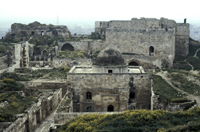
Figure 16. Lower Maqâm, from north.
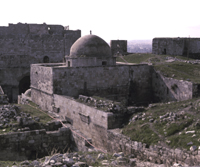
Figure 17. Lower Maqâm, from northeast.
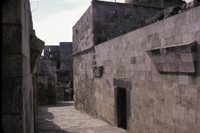
Figure 18. Lower Maqâm, east exterior.
The plan by Herzfeld seems to be seriously skewed: the courtyard is in fact much better aligned with the prayer hall.17
The earliest evidence for the holy sites on the Citadel comes from Ibn Butlân, a Nestorian physician and theologian, perhaps priest, who first visited Aleppo in 440–41/1049.18 He is quoted by the geographer Shihâb al-Dîn Yâqût (575–623/1179–1229).19
We arrived in Aleppo from al-Rusâfah on the fourth day's journey. Aleppo is a city walled in white stone, and in it are six gates (abwâb). Adjacent to the wall (fî jânab al-sûr) is a citadel (qal`ah), in the upper part of which is a mosque (masjid) and two churches, and in one of them is the altar (madhbah) on which Ibrâhîm sacrificed. In the lower part of the citadel is a cave (maghârah) in which he hid his flock.
The passage continues on the theme of Ibrâhîm, with more about the etymology of the name Halab and its relation to milk and Ibrâhîm.
Ibn Shaddâd summarizes the history of both the Lower and the Upper Maqâms.
In the Citadel there were two churches, one where Ibrâhîm al-Khalîl had built an altar (madhbah), and there was in it a stone on which he sat when he milked his flock. Subsequently there was built a congregational mosque (masjidan jami`an) in the days of the Banî Mirdâs [the Mirdâsids r. 414–72/1023–79], and it was called the Upper Maqâm Ibrâhîm. In it the khutbah was performed and it was a blessed place, which people visited.
Ibn Butlân relates in part of his Risâlah that in the Citadel of Aleppo was the altar (madhbah) on which Ibrâhîm al-Khalîl sacrificed; it was later converted to a mosque in the time of the Banî Mirdâs.
In his Ta'rîkh Ibn al-`Azîmî20 says that in the year 435/1043–44 there appeared at Baalbak in carved stone (hajar manqûr) the head of Yahyâ b. Zakarîyâ', and it was taken to Homs then to Aleppo in the same year, and interred in this maqâm in a reliquary (jurn) of white marble (rukhâm); [this reliquary] was placed in a closet (khizânah) to one side of the mihrab; [the closet] was closed and covered with a curtain (sitr) to safeguard it.
Kamâl al-Dîn b. al-`Adîm relates in his Zubdat al-Halab fî ta'rîkh Halab that al-Malik al-`Ādil Nûr al-Dîn b. `Imâd al-Dîn Zangî rebuilt (jaddada) its structure (`imârat). And in the year 609/1212, in the reign of al-Malik al-Zâhir Ghiyâth al-Dîn Ghâzî, it was destroyed by fire that occurred in it, along with tents, weapons, and war materiel (khiyam wa'l-silâh wa âlât al-harb) that were in it, but the reliquary (jurn) was not burned: God kept the fire from it. This proves that the head is indeed that of Yahyâ, as the fire did not reach it, and it was sheltered from [the fire]. Kamâl al-Dîn also says that Abu'l-Hasan `Alî b. Abû Bakr al-Harawî21 told him that in the Citadel of Aleppo in the Maqâm Ibrâhîm is a chest (sundûq) in which is a piece of the head of Yahyâ b. Zakarîyâ', found in the year 435/1043–44.
[Ibn Shaddâd continues:] The other church contained the Lower Maqâm, which is [dedicated] to Ibrâhîm al-Khalîl, and in it is a handsome stone, which is visited. They say that Ibrâhîm al-Khalîl sat on it also. I do not know which of the Muslim kings founded this maqâm, but I do know that al-Malik al-`Ādil Nûr al-Dîn Mahmûd b. Zangî restored (jaddada) it also, and adorned it (zakhrafahu), and he prayed there frequently. He built in it a reservoir (sahrîj) lined with lead, which remained full in all years, and endowed it [the shrine] with a portion of the land outside Aleppo to the west.
Ibn Shaddâd adds that when the Citadel fell to the Mongols they destroyed the mosque (the Upper Maqâm) along with other places, and the relic of Yahyâ's head was translated to the city's Great Mosque, to an enclosure (maqsûrah) east of the mihrab. It apparently remains there today, behind a grille.
Ibn al-Shihnah garbles some of the information of his sources and adds nothing essential. He concludes that there were two churches at the sites of the two Maqâms and mistakenly applies some of what Ibn Shaddâd says of the Upper Maqâm to the Lower Maqâm.
It is apparent that Ibn Butlân's account is the only one containing reliable information about the holy sites on the Citadel before the churches there were closed and the sites of the two Maqâms were Islamicized. The later writers simply tried to interpret this account in the light of what they knew themselves.
In the upper part of the Citadel Ibn Butlân saw a mosque and two churches, one of them containing the altar on which Ibrâhîm sacrificed; in lower part of the Citadel he also saw a cave in which Ibrâhîm hid his flock. There is at least one reservoir in the lower part of the Citadel that could be identified with this cave. I think of the Lower Maqâm as being “in the lower part of the Citadel,” but perhaps this is more because of its name than its location. If the two Maqâms replaced Ibn Butlân's two churches, as later writers have supposed, there was also a mosque on the Citadel that has gone unaccounted for.
I shall deal with the implications of these historical sources for the Upper Maqâm below; here Ibn Shaddâd's account of the Lower Maqâm as he knew it is what is important.
The earliest inscription at the Lower Maqâm is in the name of Nûr al-Dîn, dated 563/1167–68, the same year he founded the Madrasah al-Nûrîyah al-Kubrâ in Damascus. It records his founding of the “Mosque (masjid) of the Maqâm.”22 No one is mentioned as supervising the work. Herzfeld suggested that the use of the verb ansha'a, “founded” indicates that Nûr al-Dîn established a waqf as well as built a building, but this seems to be reading in, based on information from Ibn Shaddâd that Nûr al-Dîn constructed a lead-lined reservoir (sahrîj) and endowed the shrine. This inscription apparently belongs to the period of construction of the prayer hall as it now stands, and confirms the evidence of the masonry that Nûr al-Dîn ordered the construction of a new building, not simply repairs to something older. If one of Ibn Butlân's churches stood here, there is no trace of its walls or foundations. Ibn al-Shihnah thought that one of those churches had been abandoned, then replaced with a mosque in the time of the Mirdâsids, but that is a plain misinterpretation of Ibn Shaddâd.
This inscription of Nûr al-Dîn's is let into the facade of the prayer hall in an obviously secondary position. Its original position may have been over one of the entries to the courtyard, of which there are today two in the the east wall, facing the lane that leads from the upper entry block up to the Upper Maqâm. Most visitors would most likely have entered the Lower Maqâm from this lane.
While a double entry is appropriate for a shrine visited by pilgrims, it is also possible that one of these entries is secondary. Certainly the northern of the two entries, now ruined and overbuilt, is original. This northern entry is at the north end of the east wall. While the rest of the east wall is obviously late (it has now been restored on the exterior), this portal is in bond with the north wall of the monument and hence old. It would have opened into a vestibule, providing a bent entry into the courtyard; west of the vestibule was a set of rooms along the north side of the courtyard, sharing the north exterior wall. The first inscription would have been located appropriately over this north portal. To appreciate the chronology of construction it is necessary to consider the second inscription.
The second inscription, from 575/1179–80, names Shâdhbakht as governor. At this date al-Malik al-Sâlih Nûr al-Dîn Isma`îl ordered construction of something unspecified (`imâratihi). This young son of Nûr al-Dîn was about 16 years old in 1179. He died Friday, 25 Jumada I 577/6 October 1181, and was temporarily interred in this very monument, then translated to the ribât bearing his name and situated at the foot of the Citadel, which Ibn Khallikân described as having a fine reputation in Aleppo.23 Presumably Shâdhbakht arranged the work and chose the architect.
This inscription, too, has been disturbed. In Herzfeld's day it was set into rough masonry over the southern entry in the east wall of the courtyard, which was already a late reconstruction. It rests there now, after restoration of the exterior of the east wall. I believe that this entry replaced the northern entry, at the northeast corner of the courtyard, after damage to the eastern part of Nûr al-Dîn's building from the violent earthquake of Shawwâl (tenth month of) 575/March 1179–80. Within months, the north entry was blocked and the east wall was reconstructed, including a new south entry, with Shâdhbakht directing the work. Nûr al-Dîn's first inscription, originally over the north entry, was then placed on the prayer hall facade to preserve its message. The new south entry, however, was labelled with al-Malik al-Sâlih Nûr al-Dîn Isma`îl's inscription. This south entry eventually collapsed, too, but when it was rebuilt the second inscription was saved and reinstalled in its original place.
The third and last exterior inscription is the undated one naming Shâdhbakht as the maker of a waqf, carved on the console that is now also mounted on the prayer hall facade. Herzfeld accounted for this inscription by saying that it was contemporary with the second inscription, of 575/1179. To do so he had to argue, without presenting further proof, that while the epithet “al-Malikî al-`Ādilî,” which is applied in the inscription to Shâdhbakht, would normally have been used only before Nûr al-Dîn died (and that after his death it would have been shortened to“al-`Ādilî”), this was not done because the longer form was the usual way of referring to Nûr al-Dîn. This is not a fully satisfactory explanation, and another is possible, namely that Shâdhbakht's inscription was contemporary with the first inscription, recording Nûr al-Dîn's work of 563/1167–68.24
This is not too early for Shâdhbakht to have been active in Nûr al-Dîn's service, and if he oversaw the construction of the Lower Maqâm he may have helped fund the shrine, adding this inscription in commemoration. The wellhead to which the console must have belonged may have been damaged at the same time as the portal, and its inscription transferred to the prayer hall facade along with Nûr al-Dîn's foundation inscription. Shâdhbakht's waqf may have been the benefaction attributed to Nûr al-Dîn by Ibn Shaddâd or a waqf inscription by Nûr al-Dîn may be missing. The latter is more likely, as Ibn al-Shihnah credits Nûr al-Dîn with endowing the Lower Maqâm with a professorship for a Hanafî.
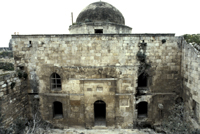
Figure 19. Prayer hall facade.
The facade of the prayer hall was opened by three large doors, one very large one in the center and two smaller ones to either side, topped by arched windows with a slightly pointed profile. All three doors have been substantially narrowed by later masonry, and the side doors have been converted to windows. But the original lintel beams are still preserved, and run for a meter or more to either side of each door. Above the wooden lintel of the central door is a flat-topped segmental relieving arch; above this level the masonry has been rebuilt. There is no decoration aside from secondary inscriptions inserted in the masonry.
This arrangement is very like that of the Shâdhbakhtîyah, and accordingly I consider the Lower Maqâm to be an early (or at least earlier) work of Qâsim b. Sa`îd, an architect employed by Nûr al-Dîn in Aleppo after Nûr al-Dîn moved his court to Damascus, leaving Shâdhbakht as governor. Under such circumstances, Shâdhbakht may have been the one to select Qâsim b. Sa`îd as the architect.
The prayer hall, almost the only original part of the building still extant, is composed of a central dome flanked by two barrel vaults. A small space to the west may have been a storeroom, or may have housed a relic, as its door and door frame were elaborately carved. On the north side of the prayer hall two columns support the springing of the rather shapeless pendentives of the central dome.
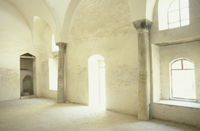
Figure 20. Interior, north side.
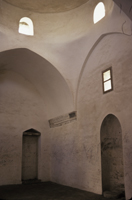
Figure 21. Interior, south side.
Nûr al-Dîn caused this prayer hall to be richly decorated, and much of this decoration survived until the conclusion of the First World War. Sometime after 1919, probably very soon after, this decoration was removed and vanished from sight. Even recognizable elements of it have not been located. It consisted of a superlative carved wooden mihrab, marble dado revetment with inscriptions inlaid with black paste, and other woodwork. There were also painted inscriptions at the springing level of the barrel vaults. Originally the large openings in the prayer hall facade must have been closed by decorated wooden doors with carved wooden soffits; one of the soffits survived until 1919.
Here more than in the Shâdhbakhtîyah the ornament of the Plain Style is supplied by interior decoration. There are no subtle manipulations of the masonry of the prayer hall of the sort seen in the Shâdhbakhtîyah, but then the vaults are probably not the original ones. The marble revetment and wooden panelling seem to have been more extensive than the marble mihrab in the Shâdhbakhtîyah, and made no use of the Ornamented Style's plasticity, as the Shâdhbakhtîyah' mihrab does. Consequently, there is no way of knowing whether Qâsim b. Sa`îd designed or specified any of this interior decoration. It could equally have been ordered by Nûr al-Dîn or Shâdhbakht, and applied in a second stage of construction. Because of the contrast between the decorative integration of the Shâdhbakhtîyah and the Lower Maqâm, and the possibility that Shâdhbakht managed the Lower Maqâm's construction for Nûr al-Dîn, it is appealing to see the Shâdhbakhtîyah as a later and more developed work of Qâsim b. Sa`îd, who by then determined more of the interior design.
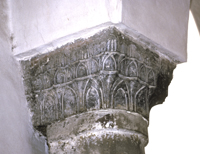
Figure 22. Muqarnas capital.
There are two architectural elements of decoration in the Lower Maqâm: the capitals atop the columns. One of the column capitals, like the columns, is Antique spoilia—from a church formerly on the site?—but the other, evidently carved for its present location, is an advanced muqarnas design, with compound corner brackets, doubled cell forms (in the lowest tier) and gored cells. The other early capital of this form which I have noticed is in the Jâmi` al-Hanâbilah in Damascus, and must date to 599–612/1207–16. The Lower Maqâm's capital may well have been carved to replace another (damaged?) Antique capital during some repair to the building. I had attributed this capital to repairs executed by al-Malik al-`Azîz in 616/1219–20, which seem to have been recorded in an inscription that is now missing and the original location of which is unknown.25 The inscription was inside the prayer hall when it was recorded, but appears to have been out of its original position even then. Lorenz Korn points out that this inscription, which names Mahmûd al-Khutluqî, could have come from his Madrasah al-Husâmîyah, near the Citadel.26
One last inscription was carved on a lost wooden frame for the window above the mihrab. Undated, it gave the name of Badr al-Dîn Aydamir as governor and that of al-Malik al-Zâhir Ghiyâth al-Dîn as sovereign. Aydamir is known to have been in al-Malik al-Zâhir's service from as early as 606/1209–10 (the date of the inscription on the Lion Gate of the Citadel entry block, which names him as wâlî) to al-Malik al-Zâhir's death seven years later in 613/1216.27 Whether this small piece of work was a restoration or a further adornment of the shrine is impossible to say. It is clear from the preservation of the perishable decoration of the interior that the building had not been seriously damaged before the Mongol invasion, and that the Mongols did not thoroughly wreck and fire the building in 658/1260, as Ibn al-Shihnah claims.28
The original stones of the prayer hall facade are finished with an untoothed tool, fine to extra fine. At the east end of the facade, the original stones are mostly only fine. The same is true of the east exterior of the prayer hall. The cutoff at the west end of the prayer hall facade is an adjustment to a later door; the stones are medium toothed long stroke on the cutoff plane. Course heights to east of central doorway: partly buried, 45, 47, 45, 27.5, 27.5; then comes the inscription, with more short stones above. To the east of the eastern doorway: partly buried, 51.5, 31, 27.5, 27.5, 27.5, 27.5.
The inscription of 563 has traces of blue paint as background, red on raised letters and frame.
Inside, the muqarnas corbels on the qiblah wall have color: on the west, traces of gold in the cells, under green paint against a blue background; on the east, traces of gold under blue in the background (the cells are green).
The undersides of the shallow but pointed arches over the doors in the east and west sides of the prayer hall are finished medium with untoothed tool, looking as if smoothed. The interior of the mihrab appears to be extra fine horizontal stroke. Course heights: partly buried, 28, 28, 28.5, 28, 28, 28.5, 31, vault of mihrab.
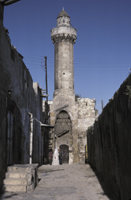
Figure 23. Masjid al-Khwâjah, general view.
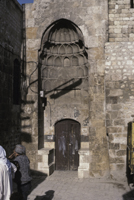
Figure 24. Portal.
A seldom-noticed mosque belongs to the group of monuments just discussed. I did not notice its relevance to this study myself until Lorenz Korn brought it to my attention, suggesting that it was probably built by Qâsim b. Sa`îd, or, less likely, Qâhir b. `Alî.29 It was published by Sauvaget as the “Madrasa Badriya (?)” without further comment than a dating in the first quarter of the thirteenth century. 30 I do not know why either the name “Madrasah al-Badrîyah,” or “Masjid al-Khwâjah,” has been applied to the building, but the restoration inscription includes Qur'ân 9:18, which appears commonly in mosques. I have not investigated the building closely, so I give here only a short description of the portal, which bears a later minaret.
Two benches with wrap-around recessed panels bordered by strongly plastic moldings flank the doorway. Topping the doorway is a joggled segmented arch, above which is a recessed rectangular panel. At the level of the top of this panel a four-tier muqarnas vault begins, and small pendentive cells or brackets in both corners of the bay rise to that same level. In the first tier of the muqarnas there are only two cells: what might be called squinches, above the small pendentives. In the second tier there are two cells on each side, and in the third there are three on each side, flanked by brackets, with a flat-backed cell in the center. The fourth tier has a full complement of eight cells, and supports a gored semidome. The vault as a whole is recessed slightly behind a frontal arch springing from rolled brackets (a suspicious feature, possibly the result of restoration).
In terms of the “Muqarnas Questionnaire,” in Appendix A, the vault is at least twice as wide as it is deep, it springs from (minimal) corner brackets, the back corners are covered by single squinch cells above the pendentive corner brackets, there are four tiers (which is very unusual outside of royal constructions), they are the same height in all tiers, and the same depth, the geometry is based on eight axes, there are no rolled square brackets in the vault itself, nor branched brackets, nor gored conches, nor domelets, there are no flues, and the top of the vault is a gored semidome. The exterior arch profile reflects the profile of the muqarnas and is enclosed within a smooth pointed arch framing it. There is no decorative archivolt.
Similarities with the portals of the Madrasah al- Shâdhbakhtîyah and the Mashhad al-Muhassin are fairly strong, especially including the device of the recessed panel within the zone of the muqarnas (if you count the small corner brackets as part of the muqarnas).
None.
This shrine, located across the valley of the Quwayq River, west of Aleppo, on the hill called Jabal Jaushan. was first developed in the tenth century as the Mashhad al-Dakkah, and later was called the Mashhad al-Muhassin, after the suppositious tomb of a Shaykh Muhassin.31 It is a palimpsest of different periods, most interesting, I believe, for a portal that is the earliest dated work of another important Syrian architect, Qâhir b. `Alî b. Qânit.
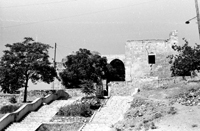
Figure 25. Mashhad al-Muhassin, general view to west.
Much of Ibn Shaddâd's account of the shrine is derived from a lost work by the Shî`î Aleppan historian Yahyâ b. Abî Tayyi' (575–625?/1180–1228).32
According to this source, the shrine was originally called the Mashhad al-Dakkah because Sayf al-Daulah the Hamdânid constructed a terrace (dakkah) there, where he sat to observe the horse races that went on below the hill. In 351/962 Sayf al-Daulah is said to have seen a light descending nearby, on a spot where a tombstone was then found, naming al-Muhassin b. al-Husayn b. Alî b. Abî Tâlib. He assembled the `Alids of the city to ask who this al-Muhassin was, and it was decided that he must have been a posthumous son of Husayn, born to one of his wives in captivity in Syria after the massacre of the `Alids at Karbalâ' in 61/680. It was also decided that al-Muhassin must have died in infancy, overcoming the difficulty that no one had heard of him previously. The story of the tombstone is a not uncommon phase in the development of Shî`î shrines, and the explanation of the name it bore, which fits poorly with the historical information that Husayn's women were taken to Damascus, not Aleppo, is a simple pious invention.
The populace moved to build a shrine on the site, but Sayf al-Daulah forestalled such a move by beginning construction himself, saying, “It is I whom God called to build here in the name of the People of the House [of the Prophet].” Ibn Abî Tayyi' says, “I have examined the portal of the mashhad. It is a small door in black stone with an arch (qantarah), over which is found a long Kûfic inscription” in the name of Sayf al-Daulah and dated 351/962, which he gives in full; it called the building a mashhad.33 The door was thus like the present north door to the Maqâm Ibrâhîm at Sâlihîn. The historian may have made this observation in his youth, as he was born in 575/1180 and this small door was replaced by the present portal in 594/1197–98. Conceivably part of Sayf al-Daulah's building is preserved in the foundations of the present building, but otherwise nothing exists of it.
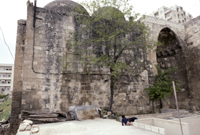
Figure 26. Southeast corner, from east.
Ibn Shaddâd continues on Ibn Abî Tayyi's authority to describe the building's later history. He credits a unnamed Mirdâsid with building “the northern masna`” (“facility”) of the mashhad. This was presumably something like the wing of the building presently standing northeast of the portal: a latrine and facility for ablution. The span of the Mirdâsid dynasty in Aleppo dates this facility to 414–72/1023–79, but it seems to have been replaced entirely.
According to the same source, in [4]82/1089 Qasîm al-Daulah Āq Sunqur, the Saljûq governor of Aleppo, built a masna` li'l-mâ', or reservoir, outside the qiblah wall (south side) of the mashhad, inscribing it with his name, and reconstructed the qiblah wall itself (hâ'it al-qiblî), which had begun to fall down. For the tomb cover (darîh) he caused to be made a cloth covering (ghishâ') and a tauq, or enclosure, with silver colonnettes or finials (`arânîs). He endowed the shrine with a mill and fields. Ibn Abî Tayyi' does not mention that Crusaders commanded by Joscelyn of Edessa twice pillaged both this shrine and the Mashhad al-Husayn, not far to the north. In 517/1123 they profaned and torched it, and in 518/1125 they damaged it further.34 Ibn Abî Tayyi' mentions work by Nûr al-Dîn and al-Malik al-Zâhir, and Ibn Shaddâd mentions subsequent work by Ayyûbids and something of the later history of the shrine (see below). From Nûr al-Dîn onward it is possible to consider the historical sources in parallel with the inscriptions.
The building as it presently exists combines many periods of construction and is not lacking in inscriptions, both in situ and relocated, which Herzfeld used to interpret the masonry. I do not follow all of Herzfeld's reasoning, although I cannot suggest a complete solution for the building's history.
The earliest elements of the building are its easternmost parts: the tomb chamber with its anteroom, the portal to its north, and a block north of the portal and projecting to the east, most of which is occupied by a large chamber covered with a mitered vault open in the center.
There is presently a walled terrace, of no great age, east of the tomb chamber and portal. The long stairway by which one climbs to the shrine is also of fairly recent date. It appears that there must always have been some level spot where the terrace is located, and there may anciently have been some enclosure wall and gate, too.
The earliest inscription preserved at the Mashhad al-Muhassin is on the east exterior wall, south of the portal, above a blocked-off door to the tomb chamber. It is large, in a fine ornamented frame, and in fine Kûfic. It names `Imâd al-Dîn Zangî and gives the date of unspecified work as 537/1142–43.
Herzfeld thought this inscription was in situ, but this is not at all clear. The masonry of the tomb chamber, which may be inspected on both the south and east sides, is not as regular in course height as the Ayyûbid masonry composing most of the building, and so could be Zangid. But the ashlars are also somewhat rough in shape and varied in composition, as if recut from material taken from some ruin. This, too, could fit a reconstruction undertaken by Zangî a generation after the Crusader sack of the shrine. But one would expect something better of Aleppan masons at this date.
Ibn Abî Tayyi', as quoted by Ibn Shaddâd, makes no mention of any construction at the shrine by Zangî, and Ibn Shaddâd adds none. That is odd, as Ayyûbid historians often read the inscriptions on a building as a guide in relating its history, and this inscription is too big to miss. It might be that the staff of the shrine, whom Ibn Abî Tayyi' and Ibn Shaddâd are likely to have consulted, themselves attributed no particular part of the building to Zangî, or it might be that Ibn Abî Tayyi' did not read inscriptions and that Ibn Shaddâd, relying on Ibn Abî Tayyi', did not bother to add any information except regarding the shrine's later history.
However, Ibn Abî Tayyi' says that Nûr al-Dîn ordered the construction of a cistern (sahrîj) in the courtyard (sahn), and a latrine or ablution area with many stalls ( mîdâh fîhâ buyût kathîrah), which was much appreciated by the residents. If there were residents, there must already have existed a set of cells, presumably around the present courtyard. Nûr al-Dîn's cistern and latrine may have replaced or supplemented the “northern masna`” built by the Mirdâsids in the previous century. The shrine was still entered by Sayf al-Daulah's portal, with the small basalt door, and the tomb chamber, whether rebuilt by Zangî or not, must have been redecorated after its pillaging by the Crusaders.
Perhaps this hydraulic work of Nûr al-Dîn's is the construction campaign commemorated by a smallish and mutilated Kûfic inscription in his name. It is set high up in the east wall of the tomb chamber above Zangî's large inscription, and most of the right half of the slab on which it is inscribed is missing.
Aside from giving the name of Nûr al-Dîn and the date 541/1146, in its present state the inscription does not indicate what construction work it pertains to. Herzfeld thought that this unframed slab was also in situ—or at least close to its original position—but this is plainly not the case. The present location of the inscription is awkward, too high, and out of character for its physical format. Herzfeld interpreted the location of this inscription in relation to Zangî's inscription, which he thought applied to the tomb chamber. As Nûr al-Dîn's inscription is dated in the year of Zangî's death in 541, Herzfeld concluded that the tomb chamber was nearly completed at that time and that Nûr al-Dîn quickly added an inscription in the only part of the masonry not yet laid, the courses up near the top of the exterior wall. This is a weak explanation, as Nûr al-Dîn could have inserted an inscription anywhere.
Even Herzfeld had to admit that the inscription had been reset in later repairs, and to bolster his hypothesis he concluded, somewhat lamely, that it was near its original location. As the stones to the right of the inscription, where text is missing, are consistent with the rest of the masonry of this part of the wall, the slab must indeed have been reset here after part of the slab was broken off. But much of the wall surrounding the inscription must have been rebuilt at the same time, a circumstance that undermines Herzfeld's conclusion that Zangî's inscription is in situ. If one admits that Nûr al-Dîn's inscription has been reset, it may well have come from another part of the building entirely. Finally, it seems odd that it should have taken four years to rebuilt the tomb chamber and its anteroom: Zangî's work should have been finished in short order, and Nûr al-Dîn's inscription should apply to something else. As no source credits him with building the tomb chamber, Nûr al-Dîn's inscription of 541/1146 may have come from an entry to his splendid latrine.
On the theory that both these inscriptions are more or less in situ, Herzfeld argued that the tomb chamber must be Zangid, and looked for confirmation to its interior. He likened the use of columns to carry the arch between the tomb chamber and the antechamber to the prayer hall of the Lower Maqâm in the Citadel, and remarked that the squinches of the tomb chamber, which have small knobs at their springings and small muqarnas cells at their upper corners, resembled domed rooms in the east wing of the Great Mosque of Hamâh. I have not yet found photographs of the relevant domes at Hamâh, but it is doubtful that they can be dated firmly, especially as that mosque no longer exists. The resemblance to the Lower Maqâm was no doubt intentional, in one direction or another, and the interior of the tomb chamber does appear to belong to the twelfth century, but it need not have been built so early as 541/1146. Sauvaget remarks the lyre-shaped capitals, connecting them to Mesopotamia, a link appropriate to either Zangî's or Nûr al-Dîn's period of rule.
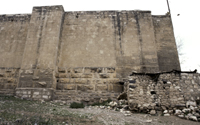
Figure 27. South wall, east end.
The masonry of the foundation and south wall of the tomb chamber is difficult to interpret. There has been much patching of the foundation at the southeast corner, and the foundation of the south wall of the prayer hall, built in 609/1212–13 and at least partially rebuilt in 632/1234–35, extends east to support part of at least one of the two buttresses that have been added to the south wall of the tomb chamber. While the key joint between these buttresses is partially obscured by a parasitic construction that I have not penetrated, the whole arrangement strongly suggests that the present lower parts of the tomb chamber were in existence when the prayer hall was rebuilt. (Unless reconstructed, the foundations of the tomb chamber should be the oldest masonry at the site.)
It may be that Zangî built something like what now exists at this corner of the building, and that it has been rebuilt several times, conserving its original form and Zangî's inscription. Nûr al-Dîn's inscription could have been moved to its present location almost at any time.
The earliest inscription that seems to be correctly associated with the architecture is on the portal. Ibn Abî Tayyi' says that the ra'îs (mayor) of Aleppo, Safî al-Dîn Târiq b. `Alî b. Muhammad al-Bâlisî, known as Ibn al-Turayrah,35 demolished the portal built by Sayf al-Daulah and rebuilt it higher and more beautiful than before.
According to Ibn al-`Adîm, Târiq b. Turayrah, as the name appears on the portal, had been ra'îs under Nûr al-Dîn's son al-Malik al-Sâlih Ismâ`îl. `Izz al-Dîn Mas`ûd, Zangid of Mausil, kept him on as ra'îs after the death of al-Malik al-Sâlih in 577/1181. When Salâh al-Dîn finally took Aleppo in 579/1183, he confirmed Ibn Turayrah as ra'îs.36 Ibn Turayrah, then, represents the same group of political leaders as Shâdhbakht, although he represented the city and its local elite rather than the Nûrî mamlûks.
The portal of Ibn Turayrah appears to have been inserted between two wings of the building, the tomb chamber on the south (whether in its present state or some earlier one) and the present northeast wing of the building.
The door frame of the portal was rebuilt in 1314/1896–97, as documented by the inscription immediately over its segmental arch. This large framed element doubtless replaced some decorative device, perhaps a set of joggled voussoirs that had deteriorated too seriously to be saved. The original foundation inscription is tucked up between the muqarnas pendentives just below the springing of the faceted dome, probably not its original position; it has been trimmed on the left side, probably when the portal was restored in 1314/1896–97. It is likely that this inscription was part of whatever masonry was replaced by the inscription of 1314/1896–97. It records the rebuilding or repair of an unnamed construction under the rule of al-Malik al-Zâhir, giving Ibn Turayrah's name as patron.37 The inscription had been thought to be undated, and Herzfeld assigned the date 585/1189 to the portal on the basis of a faulty manuscript of Ibn Shaddâd's text (see Mashhad al-Husayn). Looking closely at the inscription, Lorenz Korn has read a short pious phrase and the truncated date 594/1197–98, which I accept, at the end of the last line.38
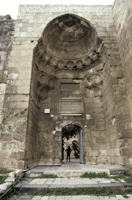
Figure 28. Portal.
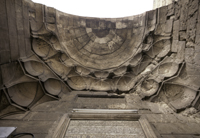
Figure 29. Portal, vault from below.
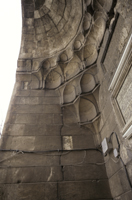
Figure 30. Portal, squinch.
The muqarnas pendentives and the lowest tier of the muqarnas of the vault are constructed of two short courses of stone for each tier, and exhibit a variety of cell profiles. The pendentives produce a half-octagonal transition to the vault, which is mitered in eight sections behind its frontal arch, rising from two tiers of muqarnas that run around the entire bay behind the frontal arch. The lower of these two tiers combines ordinary cells with brackets, and the upper tier is composed of cells formed of separate half-cells and with blunt tops. This form may be found in the corners of the muqarnas domes built for Nûr al-Dîn in Damascus; in Aleppo it appears in stone at about the same time in the minaret of the Jâmi` al-Dabbâghah al-`Atîqah.39
The portal stones are finished fine to extra fine, and the courses below the muqarnas are bevelled horizontally.
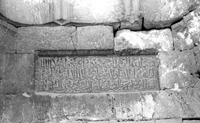
Figure 31. Portal, detail.
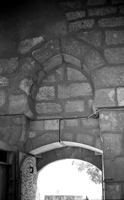
Figure 32. Courtyard side of portal.
I believe that the portal is the work of Qâhir b. `Alî b. Qânit, an architect known for works in Ma`arat al-Nu`mân, and whom I believe worked in Busrâ and Damascus, too (see below). The date 594/1197–98 falls before Qâhir b. `Alî's earliest dated building in Ma`arat al-Nu`mân.
Possibly the details I see as idiosyncratic to Qâhir b. `Alî's work were more widely used, or were added by masons working for more than one architect. Some readers may wish to think of Qâhir b. `Alî as a useful grouping or abstraction rather than as a single architect.
Nevertheless, this portal bears what must be an idiosyncratic detail: the progressive outlining of the three tiers of the muqarnas pendentive, which occurs above in the prayer hall dome of the Madrasah Abu'l-Fawâris, in Ma`arat al-Nu`mân (see below), a signed work of Qâhir b. `Alî.
There is probably no sectarian significance to Qâhir b. `Alî's involvement with this Shî`î monument. The Ayyûbids and the city's ra'îs patronized the mashhad because it was the principal Shî`î shrine of Aleppo, and doing so was a way of patronizing the Shî`ah at a time when the Sunnî domination of the city's politics continued to increase. Qâhir b. `Alî may have worked for al-Malik al-Zâhir at this time, or he may have been engaged by Ibn Turayrah for this project.
At this stage of his career Qâhir b. `Alî must already have been a successful and established architect. He might have been a rival to Qâsim b. Sa`îd in Aleppo, or a successor; in any event, his later career lay elsewhere than Aleppo.
Through the portal one enters a vaulted bay, the same size as the entry bay, that opens on the courtyard. On this side, behind the missing voussoirs that would have topped the door frame, is a pointed horseshoe arch, filled with masonry of mixed date. I have not noted the details of this bay's masonry, but I believe that its courtyard side has been heavily rebuilt.
Herzfeld's plan shows this side of the entry block as an îwân-hall, which it was originally. Later, probably when the portal was reconstructed, its opening on the courtyard was narrowed by a diaphragm arch (the piers that support this diaphragm arch are shown on Herzfeld's plan without hatching). The masonry of this side of the entry is important for establishing the date of the wings of the building that abut it on both sides, and deserves further detailed study.
The voussoirs of the pointed diaphragm arch are surrounded by horizontal courses of stones filling the outline of a taller pointed arch. This outline, which is also a break in bond, is abutted by horizontal courses. I interpret the masonry under the outline as the infill of the vestibule's original large arched opening onto the courtyard. That opening would have had a frontal arch of voussoirs that is plainly missing, on both the north and south sides. Therefore the original masonry of the courtyard side of the entry has been replaced at least above the springing of its vault. The outline of the original îwân-hall's frontal arch is preserved in the trace of its infill.
It is not clear how much of the original courtyard facade of the vestibule and the northeast block is now missing.
On the south side lies the anteroom to the tomb chamber. On the exterior of the building there is a clean vertical joint between the anteroom and the portal. On the courtyard side there is a vertical joint in the lower part of the masonry up to a stone that is probably the springer of the original frontal arch. All else is later replacement and patching, and I do not see any evidence here for the date of the anteroom and, hence, the tomb chamber.
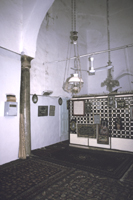
Figure 33. Tomb chamber.
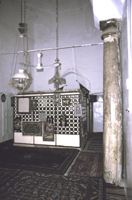
Figure 34. Tomb chamber.
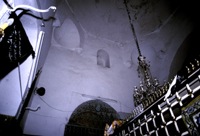
Figure 35. Tomb chamber.
On the north side, the exterior juncture between the portal and the northeast wing is also a clean vertical joint. On the courtyard side, the pier of the vestibule's arch infill includes a piece of Zangid spolia with a decorative braided fillet. I attribute this stone to the same lost construction of Nûr al-Dîn that his inscription belonged to.40 Below the springing of the arch, the joint between this infill pier and the immediately adjacent masonry of the northeast block (the remains of the north outer corner of the original vestibule's îwân-hall) is smooth, but this abutting masonry is only a thin vertical strip, joined raggedly to the rest of the facade to the north. This ragged joint might suggest that the northeast block was built later than the vestibule, but it could also be the result of the heavy repairs to the courtyard facade. This evidence must remain inconclusive until it is studied more closely.
Taking a short leap, I conclude that the original vestibule may have been in bond with the northeast wing or built against it, with a clean vertical joint, but that later work has obscured this fact.
The northeast wing is consequently undated. I think that it is not the latrine built by Nûr al-Dîn, but a replacement for that facility, or even an addition to it, as Nûr al-Dîn's latrine could have been almost anywhere along the north or west side of the building. Both these wings have been rebuilt since Nûr al-Dîn's day save the northwest corner, for which see below.
The northeast wing is entered through a passageway opening on the northeast corner of the courtyard. From this passageway a stairway rise to the roof of the building; the passageway itself leads to a large square room covered with a groined vault opened at the center by a square oculus. This chamber, now disused, was formerly a kitchen or bakery, with the result that its interior is entirely covered with soot. Herzfeld's plan shows this room as a latrine, with stalls against the west wall, of which I observed no trace. Nor can I substantiate the existence of a doorway in the north side of the chamber, apparently shown on the plan as blocked by the oven presently occupying that side of the room.
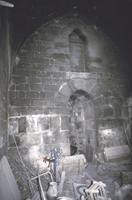
Figure 36. West wall of northeast wing.
In the lower part of the west wall of this northeast chamber, in line with the east facade of the main building, there are several courses of stones much larger than the rest of the masonry. These are presumably remains of an earlier construction, perhaps the original exterior wall of the shrine.
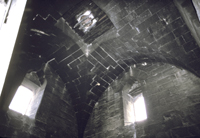
Figure 37. Trilobed arches in northeast chamber.
High up in the four sides of the chamber are small windows, topped on the inside with trilobed arches that have inverse keys. This is a detail characteristic of Qâhir b. `Alî's designs.
I conclude that the northeast wing is probably a work of Qâhir b. `Alî, built at the same time as the portal but not in bond with it. Whether it replaced Nûr al-Dîn's latrine or was built for some other purpose I cannot say. Sauvaget attributed both this shrine and the Mashhad al-Husayn to the two brothers named in an inscription above the mihrab of the Mashhad al-Husayn, but on no firm grounds aside from the observation that both shrines possess a wide variety of vaults, sometimes showy ones. This variety, of course, is partly due to a complex construction history in the case of the present monument. More widely, it can be viewed as typical of shrine architecture, where interior decoration too may be applied more thickly and in a variety of styles, paralleling the variety of offerings that may be on display within. Some of the architectural variety, especially in the Mashhad al-Husayn, may also be due to a desire by architects and masons, some of whom may have been donating their labor in devotion, to produce exemplary work. In any event, the inscription on the mihrab belongs to its decorators, not the architects of the building.
Ibn Abî Tayyi', again as quoted by Ibn Shaddâd, wrote that in 613/1216, when Ibn Turayrah's son, the ra'îs of Aleppo Wâlî al-Dîn Abu'l-Qâsim died, he was buried beside the reservoir (masna`), and that the gate (bâb) with the inscription of Qasîm al-Daulah (the Saljûq, dated 482/1089) was demolished, and his own name inscribed over the new gate (of the reservoir). This reservoir is the one Qasîm al-Daulah Āq Sunqur built outside the qiblah wall of the mashhad, inscribing it with his name, at the same time he reconstructed the qiblah wall itself. I surmise from the rest of Ibn Abî Tayyi's remark that Wâlî al-Dîn in fact rebuilt the reservoir, adding an inscription, and that he was buried near it; or, perhaps, that he intended to rebuild the reservoir and it was done only at his death, when his waqf came into effect. Reconstructing the reservoir went with rebuilding the qiblah wall: Āq Sunqur did them both at the same time, and al-Malik al-Zâhir and Wâlî al-Dîn did them only four years apart. So far as I know, there are no remains of the reservoir now, nor of Wâlî al-Dîn's grave.
Ibn Shaddâd adds that the south wall of the shrine (hâ'it al-qiblî), was rebuilt under al-Malik al-Zâhir, after it fell down. This statement is matched by an inscription in al-Malik al-Zâhir's name, dated 609/1212–13, set in a chamfered frame in a spandrel of the prayer hall's courtyard facade. Although it refers only to “this area,” I see no reason to doubt that this inscription is in situ.41 But the dome over the central bay of the prayer hall may be later.
Ibn Shaddâd says that under al-Malik al-Nâsir Yûsûf (634–58/1237–60), grandson of al-Malik al-Zâhir, the north wall (hâ'it) fell down and was reconstructed on his orders. This must be Ibn Shaddâd's interpretation of the inscription on the north facade of the courtyard, which praises the Shî`î imams and gives the date 632/1234–35, in the name of Nâsir Yûsûf's father, al-Malik al-`Azîz (613–634/1216–37). The inscription is cut across the stones of masonry that is in bond. It therefore is in situ and, if contemporary with the masonry to which it is applied, dates that wing of the building to the reign of the father, not the son.
Ibn Shaddâd adds that al-Malik al-Nâsir Yûsûf also constructed the raushan al-dâ'ir in the qâ`ah of the sahn, that is, “the present cupola” in the prayer hall.42 This is the present antemihrab dome, as Herzfeld pointed out. Perhaps it was actually built by the son, not the father, and some confusion of the two pieces of work led to Ibn Shaddâd's misattribution of the north wing.
The prayer hall is composed of three bays: the central dome and two domed side bays. Both side domes rest on simple split pendentives, adjusted to the circle of the dome with small trapezoidal shapes like extremely shallow split pendentives, the same device used in the Madrasah Abu'l-Fawâris in Ma`arat al-Nu`mân. The mihrab is a simple niche, presumably because it has lost its former decoration. Contrary to Ibn Shaddâd's account and an observation made by Herzfeld, the central dome does not have windows, at least presently. It may have been rebuilt or the windows Herzfeld says he observed may have been filled in and plastered over. This dome rests on a complete tier of muqarnas cells, which fudge the transition from the octagon formed at the top of the two-tier muqarnas pendentives, which rest on brackets.
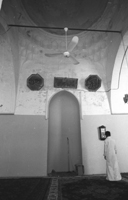
Figure 38. Mihrab and dome.
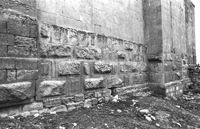
Figure 39. Qiblah wall, exterior of mihrab.
On the exterior the mihrab protrudes like a buttress. Like the rest of the qiblah wall, it rests on a foundation of marginally drafted masonry that must largely date to 609/1212–13.
The exterior of the building from the west end of the prayer hall around to the northeast wing is a succession of buttresses and changes in masonry, which deserves closer examination. I have not visited the room in the northwest corner of the building marked as Zangid on Herzfeld's plan. Sauvaget reported it to consist of a domed room and a small chamber partly open to the sky, separated by a beam (?doubleau) on two engaged columns with Corinthian capitals. This may have been the latrine or kitchen as built by Nûr al-Dîn.
According to Ibn Shaddâd the Mongols sacked the shrine in 658/1260, and it was restored by Baybars. No epigraphic evidence of Baybars's work remains except for a fragment of Mamlûk thuluth used for stone in the foundation of the west end of the qiblah wall, evidently as a patch.
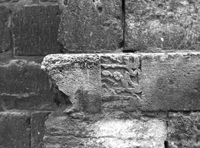
Figure 40. Fragment of inscription in exterior of qiblah wall.
Portal. The portal stones are fine to extra fine, and below the vault most of the original stones are bevelled horizontally. Course heights on south side of portal bay: 35, 35, 34.5, 34.5, 34.7. The muqarnas is medium toothed, medium stroke.
Northeast Wing. The exterior of the northeast wing, east of the portal, is medium to coarsely toothed, medium to long stroke; course heights: bedrock, 29, 33.5, 47, 39, 47. The groined kitchen room is medium to coarsely toothed, medium to long stroke, course hts at entry: partly buried, 48, 46, 47.5, 46.5.
Exterior. In the exterior of qiblah wall the masonry is varied. The rusticated stones are rough-centered with medium toothed, medium stroke margins; some margins were cut with an untoothed tool.
Courtyard. The east facade of the courtyard is mostly medium toothed, medium stroke, except where the masonry is irregularly coursed.
The prayer hall facade is also medium toothed, medium stroke, with some extra fine finish, applied with an untoothed tool. Prayer hall facade course heights: partly buried, 37, 35, 34, 34, 37. The west side of the courtyard is a late reconstruction. The north facade of the courtyard is medium toothed, medium stroke; course heights: partly buried, 48, 47.5, 47.5, 47.5.
In the Ayyûbid monuments of the small town of Ma`arat al-Nu`mân, eighty kilometers south of Aleppo, one can trace the further career of Qâhir b. `Alî b. Qânit, who probably used the nisbah, or patrionymic, “al-Sarmânî.”43
His two earliest extant works are the Madrasah Abu'l-Fawâris at Ma`arat al-Nu`mân and the minaret of that city's Great Mosque.44
I first wrote about these buildings in connection with the classical revival of the twelfth century, before I traced later buildings by the same architect; those are now described below, in Chapter Six.45
Qâhir b. `Alî or his family came from Sarmîn, which is a small town between Ma`arat al-Nu`mân and Aleppo, and he appears to have been trained in Aleppo. The inscriptions on his buildings in Ma`arat al-Nu`mân show that he was employed by al-Malik al-Mansûr Muhammad b. Tâqî al-Dîn `Umar, a cousin of Salâh al-Dîn, who ruled Hamâh and other cities from the death of his father in 589/1193 to his own death in 617/1221.46
As will be seen in Chapter Six, Qâhir b. `Alî went to Damascus and Busrâ in the late 590's/ca. 1200 to work on al-Malik al-`Ādil's castles there. He may have left Ma`arat al-Nu`mân as early as 597/1200, when al-Malik al-Mansûr Muhammad lost the city to al-Malik al-Zâhir. Qâhir b. `Alî built a tomb in Damascus for Fakhr al-Dîn b. al-Muqaddam, who died in the same year. Qâhir b. `Alî may have stayed in Ma`arat al-Nu`mân only a few years, leaving for work in Damascus either under orders from al-Malik al-Zâhir or to avoid his jurisdiction.
The Madrasah Abu'l-Fawâris bears an inscription dating it to 595/1199 and naming Abu'l-Fawâris Naja' b. `Abd al-Karîm b. `Alî b. Mu`âfâ as the founder, in the time of al-Malik al-Mansûr.47 Abu'l-Fawâris has not been identified, but he must have been an important local man or a top administrator for al-Malik al-Mansûr.
The portal projects from the east facade of the madrasah, on the west side of a narrow street. Its masonry, plain on all faces but the back wall of the entry bay, rises to a trilobed mitered vault, the stones and archivolt of which are bevelled on all their edges. The portal is topped on the exterior by a plain raked cornice. The benches on either side of the bay are nearly buried by the present paving, which is flush with the street level. On the back face of the bay a plain door frame supports a simple monolithic lintel. Above the lintel two corner stones are cut to fit a relieving arch of two asymmetrical voussoirs, forming a joggled relieving arch designed to appear as four hexagons set in a square with their top and bottom edges connected. A rectangular strapwork interlace design composed of doubled grooves and derived from an octagonal grid crosses these stones, bounded by a square outline exactly the width of the relieving arch. Within the strapwork are two short inscriptions giving the name of the architect and supervisor of construction. To either side of the strapwork frame, on the corner blocks, are two hexagonally generated medallions in relief, the points of which are set against circles, and which differ from each other only by a rotation of 60°. Immediately above the joggled voussoirs the four-line foundation inscription begins, set in a recessed frame in the springing course and the lowest course of the mitered vault.
The frontal arch of the portal, trilobed and fitted with two inverse keys, is the model for and direct forerunner of the North Gate of the Citadel of Damascus, built by Qâhir b. `Alî some twenty years later. The structurally perverse inverse keys are a development from the corresponding voussoirs in the portal of the Madrasah al-Muqaddamîyah in Aleppo, which are inversely tapered but visually more plausible.
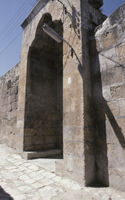
Figure 41. Madrasah Abu'l-Fawâris, portal.
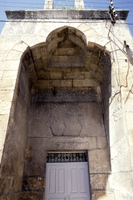
Figure 42. Portal, detail.
Through the portal one enters a domed vestibule open to the east side of the courtyard beyond. The dome is borne on simple split pendentives, and is formed as a twelve-sided mitered vault with a twelve-petalled relief ornament in the center. To the right (north) a small door leads into a tomb chamber, also domed. On the lintel of this door there is an illegible inscription in Ayyûbid naskhî.
The unarcaded courtyard is bounded on the south by the prayer hall and on the north by a wing composed (according to Herzfeld's plan) of three large rooms, perhaps rebuilt and replacing an original block of cells. The original facade on the east, the side of the portal, is missing, and the west facade of the courtyard has also been replaced by later masonry. Creswell was of the opinion that there was an îwân-hall on the west side of the courtyard, but I see no sign of it. However, in Ayyûbid Syria a madrasah had to have an îwân-hall, and the west side of the courtyard would have been both the obvious and an appropriate place for one.
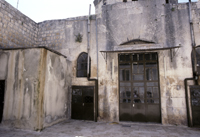
Figure 43. Prayer hall facade, south side.
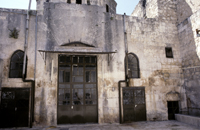
Figure 44. Prayer hall facade, north side.
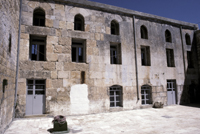
Figure 45. Courtyard facade, east side.
The facade of the north wing is composed of six vertically aligned columns of lights and, in the lowest tier, doors. There appear to have been two doors, in the westernmost column and the second column from the east. The windows in this lowest tier are topped by segmental three-stone arches, flat above and coursed with the rest of the masonry, without distinctive treatment of the course above the arch. The doors are simple, their lintels merely long blocks set in the regular coursing. So are the tall windows of the second tier. The third tier is composed of shorter windows topped by pointed, two-stone arches. The coursing at this level has been disturbed by repairs, but there appears to have been no attempt at decoration or decorative manipulation of the masonry. The wooden shutters and doors of the openings were the only decoration on this side of the courtyard. The resemblance to the prayer hall facade of the Madrasah al-Shâdhbakhtîyah is striking, and I have suggested above that the missing lateral facades of the Shâdhbakhtîyah's courtyard were arranged in this fashion.
The facade of the prayer hall also, of course, resembles that of the Lower Maqâm Ibrâhîm in the Citadel of Aleppo. The most significant difference is really that wooden beams are not used in the madrasah's facade, being replaced by plain stone lintels. The large central doorway and the two flanking sets of doors and windows are the same, but these flanking elements are smaller and a bit closer to the central doorway. This difference reflects the lower side vaults of the madrasah's prayer hall. The central dome of the prayer hall was apparently proportionally taller than that of the Lower Maqâm's prayer hall, though the top of the facade of the Lower Maqâm's prayer hall has been altered in rebuilding. In the madrasah the entire height of the facade is preserved in the center, where a set of very tall and widely angled voussoirs relieves the lintel. This relieving arch apparently extended above the cornice line, drawing the eye up to the octagonal drum of the dome, which is pierced by windows crowned with small cusped ornaments and set off by a cavetto coping, like the drum of the Lower Maqâm's dome.
These three buildings—the Lower Maqâm, the Shâdhbakhtîyah, and the Madrasah Abu'l-Fawâris—can be seen as three realizations of the same general plan, but the Ma`arat al-Nu`mân building is perceptibly different in details. In the prayer hall facade, Qâhir b. `Alî has drawn the parts of the facade toward the center and emphasized the vertical thrust of the dome. Once again, however, the decoration was presented in the wood of the doors and window closures, not in the stones of the masonry.
Within, the prayer hall follows those of its sister monuments, with two lateral vaults opening into the central domed space. Here these are simply unadorned barrel vaults. The mihrab is of stone, undecorated save for the moldings that mark it off from the surrounding wall, with which it is in regular bond. Presumably the mihrab was stuccoed and painted, like the mihrab in the Mashhad al-Husayn, discussed below.
The dome over the mihrab is the most ambitious element of the building, and makes an interesting comparison with the dome of the Shâdhtbakhtîyah. It is set on muqarnas pendentives of restricted scope. Each pendentive has only two tiers of cells, rising from brackets, themselves formed like small split pendentives. Although there are some minor differences among the four pendentives, they all appear to follow a pattern in their outlining: the bracket, at the bottom, is clearly outlined against a slightly raised background; above the bracket, the lower tier of muqarnas is outlined, but there is no raised background; and in the top tier there is no outlining at all, but a smooth transition between the surfaces of the muqarnas cells and the adjacent surfaces. This pattern of outlining appears in the previous year in the portal of the Mashhad al-Muhassin, and it is the idiosyncratic detail from which I conclude that the Aleppo shrine is a work of Qâhir b. `Alî.
The pendentives come up short against the octagonal drum, opened by eight small windows topped alternately with shell nicheheads and cusped trilobes with chamfered edges. At the level of the top of the windows a transition to a short sixteen-sided section is made by means of small trapezoidal shapes resembling extremely shallow split pendentives. This sixteen-sided section is fudged into the cavetto molding beneath the dome itself, which might have been bevelled horizontally, like the dome of the vestibule of the Madrasah al-Shâdhbakhtîyah. Another signature of Qâhir b. `Alî is carved in relief (in naskhî) on the cavetto on the qiblah side.
By contrast, the Shâdhbakhtîyah dome uses curved split pendentives, lacks a drum, and fudges the transition from octagon to circle with bosses for suspension of lamps. It is correspondingly lower, admits less exterior light, and flows into the side vaults more smoothly; the Abu'l-Fawâris dome is distinctly constructed of parts.
The portal of the Madrasah Abu'l-Fawâris invites comparison with that of the `Ādilîyah in Damascus, a late Ornamented Style building, with which it shares a strapwork interlace of doubled grooves traced across polygonal stones of a variant geometry. But the building is otherwise in the Plain Style, and despite the strapwork the portal lacks the plasticity of the Ornamented Style. Aside from the trilobed vault of the portal no masonry is bevelled. Moldings are scarce. Even the mihrab is plain. By this date the Plain Style was well established as the dominant style of northern Syria.
The stones of the prayer hall facade are finely finished, as if smoothed with an untoothed tool, or finished extra fine. The north facade on the coutryard is medium to finely finished, as if smoothed with an untoothed tool. The vestibule is extra fine. The mihrab is extra fine with courses 43 to 45 cm. high. Court heights, courtyard facade of prayer hall east of the central opening: 61 (partial?), 45.5, 45, 51.5; to west of western opening: partly buried, 49, 48, 49.5, 48, lintel. The tomb is finished medium to finely finished, as if smoothed with an untoothed tool. The outer face of the portal, south side, is finished finished medium to finely finished, as if smoothed with an untoothed tool. Course heights of south side of portal: partly buried, 44, 43.5, 41, 42, 42. The outer sides of the edges of the portal, where it is set back, are medium-toothed, medium stroke horizontally and vertically.
The minaret of the Great Mosque, built by al-Malik al-Mansûr Muhammad, is signed by Qâhir b. `Alî.48 Those considerations narrow its possible date to 595–97/1199–1200.
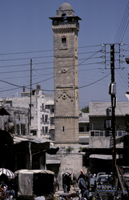
Figure 46. Great Mosque Minaret, Ma`arat al-Nu`mân (83-99/23).
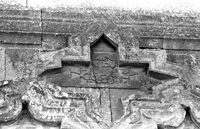
Figure 47. Signature of Qâhir b. `Alî.
The minaret is a copy of the minaret of the Great Mosque of Aleppo, then a century old, designed by a Sarmânî who may have been an ancestor of Qâhir b. `Alî. The later minaret has almost all the relief of the ornamented style (archaistic, at this date), but none of its plasticity: the moldings are flat and angular, the effect brittle. Without the architectonic elaboration of the Aleppo minaret, the stories edged by the flat moldings do not grow from each other, appearing more like a stack of varied toy blocks. This style is a revival of a revival, used to refer specifically to the Aleppo minaret, which must have been famous in northern Syria by the end of the sixth/twelfth century.49
It stands at the northwest corner of the mosque; its full height of six stories, including the cupola at the top (whose balustrade is later) and not counting the half-story at its base, is visible only from the exterior, north side. It has a square staircase around a central square shaft, entered on the south side at second-story level through a small door of reused rectangular basalt architrave blocks. With the exception of the fine molding that supports the rather flat frame of the first story, none of the frames of the other stories (the second story lacks any frame) stands on a plinth, a significant departure from the Aleppo model. The first story's double arch of broken curves and angles, supported by an engaged column with muqarnas capital, uses the same molding as the story's larger frame, with which it intersects at top. There is no bevelling in either the base half-story or the first story. The second story is plain except for bevelling along the horizontal joints, small arched windows with varied, cusped heads, and a muqarnas cornice on which the framing molding of the third story rests directly. Here too the masonry is bevelled horizontally, and five-lobed arches use the same molding as the fram of the story. The ten-sided star frame for the windows in this and the fourth stories strikes a distinctly discordant note, and it is a sign of the architect's inexperience that the five-lobed arches of this story do not intersect the enframing molding, instead stopping dead against it. The fourth story is framed, horizontally bevelled, and otherwise plain save for the star-framed windows. The fifth story differs only in having larger windows with lobed arched tops and balustrades (cf. the Aleppo minaret), and in being topped by a cornice of muqarnas blocks on which small arches rest (again cf. the Aleppo minaret). The frames of the fourth and fifth stories have the small pointed ovals in their upper corners that are characteristic of North Syrian stone architectural ornament—details notably lacking elsewhere on the shaft where one might expect them.50 The sixth story is a small cube, vaulted in brick, surrounded by a later balustrade.
The stones of the minaret, where exposed to view, are finely finished, as if smoothed with an untoothed tool, to to extra fine (in which finish it is not possible to see the tool marks clearly).
1. Ibn Khallikân, trans., v. 4, pp. 505–08; Ibn al-Athîr, Al-kâmil, trans. RHC, Hist. Or., v. 1, pp. 609, 614–15, 618–25; and Andrew Ehrenkreutz, Saladin, pp. 119–22, 130–39, 144–46, 149–51, 180–82. Ehrenkreutz, perhaps following Elisséeff, Nûr ad-Dîn, v. 2, p. 697, identifies the incumbent ra'îs (qâdî, according to Elisséeff), one of the Banu'l-Khashshâb, as the leader of the Shî`ah during this episode. I had thought that the Banu'l-Khashshâb must have been Sunnî, but David Morray, An Ayyubid Notable and his World: Ibn al-`Adîm and Aleppo as Portrayed in his Biographical Dictionary of People Associated with the City, Leiden, 1994, pp. 73–78 shows the contrary, brings out Bahâ' al-Dîn ibn al-Khashshâb's sectarian interest in the Shî`î shrines, and notes the attacks on houses of the rich during the riots.
2. He is mentioned in Ibn al-`Adîm's Zubdat al-Halab, s.a. 577, at the time of al-Malik al-Sâlih's death, v. 3, pp. 40, 42, 45, 48.
3. For political aspects of Ayyûbid rule in Aleppo see Anne-Marie Eddé, La principauté ayyoubide d'Alep (579/1183–658/1260) (Freiburger Islamstudien, v. 21, 1999).
4. Ibn Khallikân, trans., v. 2, p. 651, n. 1; Ibn al-`Adîm, Zubdat al-Halab, v. 3, p. 18. For a black eunuch who may well have been Shâdhbakht, see also Ibn al-Athîr, Al-kâmil, trans. RHC, Hist. Or., v. 1 p. 609; he was at Urfa at the death of Nûr al-Dîn.
5. Ibn Shaddâd, A`lâq (Aleppo section), pp. 113–14; Muhibb al-Dîn Muhammad ibn al-Shihnah (continuator of Ibn Shaddâd), Al-durr al-muntakhab li-ta'rîkh mamlakat Halab, ed. Yûsuf Sarkîs al-Dimashqî, pp. 116, 121; trans. Jean Sauvaget as “Les perles choisies” d'Ibn ach-Chihna, pp. 121–22, 129.
6. According to Herzfeld. One of these, below the window of the tomb, I have missed and cannot verify; Herzfeld, MCIA Alep, pp. 255–60.
7. Herzfeld, MCIA Alep, pp. 227–29, including Sunqurjâh's undated tombstone in the Sâlihîn cemetery; Ibn Shaddâd, A`lâq (Aleppo section), p. 94; Ibn al-Shihnah, text, p. 108, trans., p. 104.
8. See Ibn al-Shihnah, text, pp. 106–07. See also the discussion of the Citadel below, and cf. Dominique Sourdel, “Esquisse topographique d'Alep intra-muros a l'epoque ayyoubide,” Annales Achéologiques de Syrie, v. 2, 1952, pp. 109–33, p. 112, where the Dâr al-`Adl is incorrectly located by reference to al-Malik al-Zâhir's as yet unbuilt ramp, not the contemporary ramp, which was well to the east.
9. Creswell, “Cruciform Plan,” pp. 5–6, 11–12, with plan, called the Madrasah al-Ma`rûf; Creswell, MAE 1, p. 253, a note, and fig. 155, the dome of the prayer hall; Heinz Gaube and Eugen Wirth, Aleppo: Historische und geographische Beiträge zur baulichen Gestaltung, zur sozialen Organisation und zur wirtschaftlichen Dynamik einer vorderasiatischen Fernhandelsmetropole (Beihefte zum Tübinger Atlas des vorderen Orients, no. 58), 2 v., Wiesbaden, 1984, p. 364, no. 167, incorrectly attributing the original construction to Nûr al-Dîn because of a misreading of Ibn Shaddâd.
10. Personal communication, Thierry Grandin, 20 November 1992.
11. Ibn Jubayr, Rihlah, Beirut, 1964, p. 226, trans. Broadhurst, p. 262.
12. I cannot say whether the wooden beam here is original or not.
13. The arch is not pointed, as it has a flat-bottomed keystone.
14. Herzfeld, MCIA Alep, pp. 241, 258–59.
15. MCIA Alep, pp. 121–22.
16. Ibn Shaddâd, A`lâq (Aleppo section), pp. 39–40; Ibn al-Shihnah, text, p. 75–76, trans., p. 4; Herzfeld, MCIA Alep, pp. 117–32; Allen, Classical Revival, pp. 61–62 and n. 18.
17. Cf. Moritz Sobernheim's plan, “Die arabischen inschriften von Aleppo,” Der Islam, v. 15, 1926, pp. 161–210.
18. On Ibn Butlân see EI2, s.v.
19. Yâqût, Mu`jam al-buldân, ed. Ferdinand Wüstenfeld, Jacuts geographisches Wörterbuch, v. 3, p. 306.
20. Apparently Muhammad b. `Alî al-`Azîmî, 483–556/1090–1161, a lost source; see Claude Cahen, La Syrie du nord a l'époque des croisades et la pricipauté franque d'Antioche, Paris, 1940, pp. 42–43.
21. Author of the Kitâb al-ishârât ilâ ma`rifat al-ziyârât, ed. Janine Sourdel-Thomine, Damascus, 1953; he died in Aleppo in 611/1215, two years after the fire in the Citadel; this passage, without further elaboration, appears on p. 4.
22. Herzfeld, MCIA Alep, p. 119.
23. Ibn Khallikân, trans., v. 3, p. 342.
24. Alternately, it is just barely possible that the epithet refers to the Ayyûbid al-Malik al-`Ādil b. Salâh al-Dîn, who ruled in Aleppo in 579–82/1183–86.
25. Sobernheim, op. cit., pp. 205–06; Herzfeld, MCIA Alep, pp. 130–31; RCEA, v. 10, no. 3833, p. 162. Perhaps this is the eroded and (to me) illegible inscription mounted above and between the two late doors in the west wall of the courtyard.
26. Personal communication, 9 July 1998, pointing out also that it may have been the same inscription as RCEA, v. 10, no.3824, pp. 156–57.
27. Herzfeld, MCIA Alep, p. 130 and pl. 41d for the window frame; pp. 85–86 for Aydamir's dates.
28. Loc. cit.
29. Personal communication, 9 July 1998.
30. Sauvaget, “L'Architecture Musulmane en Syrie,” pp. 38, 41, pl. 16 b; Gaube and Wirth, Aleppo, no. 32, pp. 87, 92, and 348, dating it by its Mamlûk restoration inscription.
31. Ibn Shaddâd, A`lâq (Aleppo section), pp. 48–50; Ibn al-Shihnah, text, pp. 85–87, trans., pp. 85–88; M[oritz] Sobernheim, “Das Heiligtum Shaikh Muhassin in Aleppo,” Mélanges Hartwig Derenbourg (1844–1908), Paris, 1909, pp. 379–90; RCEA, no. 3791, v. 10, p.134; Herzfeld, MCIA Alep, pp. 193–201. Elisséeff, “Les monuments de Nûr ad-Dîn,” p. 7, no. 1; Gaube and Wirth, Aleppo, no. 652. Korn, “Ayyubidische Architekur,” catalogue, “Aleppo,” no. 97.
32. See EI 2, s.v., “Ibn Abî Tayyi'.”
33. Herzfeld, op. cit., p. 194 on the inscription.
34. Allen, Classical Revival, pp. 18–19, n. 20.
35. For the vocalization see Ibn Shaddâd, loc. cit.
36. Ibn al-`Adîm, Zubdat al-Halab, v. 3, pp. 18, 48, 71.
37. It gives the name of Ibn Turayrah's father as Yahyâ, according to Herzfeld.
38. Korn, personal communication, 15 February 1996, from research on his dissertation, tentatively titled “Bautätigkeit und Politik unter den Ayyubiden in Ägypten und Syrien.”
39. I leave the authorship of this minaret open.
40. But it would be fanciful to suggest that this Ornamented Style fragment comes from a work of Nûr al-Dîn's architect Sa`îd al-Muqaddasî.
41. Herzfeld felt that it was reset after a reconstruction by al-Malik al-`Azîz; see below.
42. Incorrectly translated by Sauvaget in his translation of Ibn al-Shihnah, p. 88, ll. 8–9. Herzfeld translated raushan al-dâ'ir as “lanterne à fenétres,” and claimed to have seen windows in the base of the antemihrab dome.
43. Herzfeld, DS–II, p. 39. Herzfeld gives the architect's full name in Latin script as Qâhir b. `Alî b. Qânit al-Sarmânî, but the nisbah “al-Sarmânî,” which is lacking in the Arabic text, does not appear in either of the three signed inscriptions I can check, those on the lowest story of the minaret, the portal of the madrasah, and the dome of the madrasah. On Ma`arat al-Nu`mân, see Nikita Elisséeff's article in EI2, s.v.
44. Creswell, “Cruciform Plan,” pp. 6, 12–13, pl. 1b.
45. Allen, Classical Revival, pp. 95–97.
46. On al-Malik al-Mansûr Muhammad see Ibn Khallikân, trans., v. 2, p. 392, where he is mentioned in his father's biography, and Humphreys, From Saladin to the Mongols, pp. 83, 170–71.
47. Herzfeld, DS–III, pp. 5–6 and fig. 96–97; Korn, “Ayyubidische Architekur,” catalogue, “Nordsyrien,” no. 10.
48. Herzfeld, DS–II, p. 39; RCEA, no. 3519, v. 9, p. 224; Korn, “Ayyubidische Architekur,” catalogue, “Nordsyrien,” no. 9. Elisséeff, in EI2, unaccountably considers the minaret to be a multiperiod structure.
49. Herzfeld, DS–II, pp. 36–39 and fig. 56, 60, and 63; the elevation of the minaret, fig. 52, is quite schematic.
50. For more on the ovals, see Allen, Classical Revival.